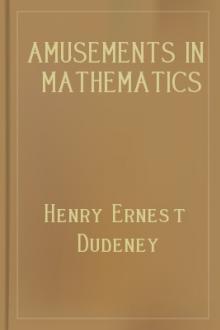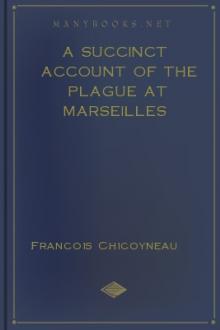Amusements in Mathematics, Henry Ernest Dudeney [books to read to be successful txt] 📗

- Author: Henry Ernest Dudeney
- Performer: 0486204731
Book online «Amusements in Mathematics, Henry Ernest Dudeney [books to read to be successful txt] 📗». Author Henry Ernest Dudeney

I will put the young geometer in the way of a rigid proof. First prove that twice the square of the line AB equals the square of the distance BG, from which it follows that HABN are the four corners of a square. To prove that I is the centre of this square, draw a line from H to P through QIB and continue the arc HK to P. Then, conceiving the necessary lines to be drawn, the angle HKP, being in a semicircle, is a right angle. Let fall the perpendicular KQ, and by similar triangles, and from the fact that HKI is an isosceles triangle by the construction, it can be proved that HI is half of HB. We can similarly prove that C is the centre of the square of which AIB are three corners.
I am aware that this is not the simplest possible solution.
198.—THE EIGHT STICKS.—solution
The first diagram is the answer that nearly every one will give to this puzzle, and at first sight it seems quite satisfactory. But consider the conditions. We have to lay "every one of the sticks on the table." Now, if a ladder be placed against a wall with only one end on the ground, it can hardly be said that it is "laid on the ground." And if we place the sticks in the above manner, it is only possible to make one end of two of them touch the table: to say that every one lies on the table would not be correct. To obtain a solution it is only necessary to have our sticks of proper dimensions. Say the long sticks are each 2 ft. in length and the short ones 1 ft. Then the sticks must be 3 in. thick, when the three equal squares may be enclosed, as shown in the second diagram. If I had said "matches" instead of "sticks," the puzzle would be impossible, because an ordinary match is about twenty-one times as long as it is broad, and the enclosed rectangles would not be squares.

199.—PAPA'S PUZZLE.—solution
I have found that a large number of people imagine that the following is a correct solution of the problem. Using the letters in the diagram below, they argue that if you make the distance BA one-third of BC, and therefore the area of the rectangle ABE equal to that of the triangular remainder, the card must hang with the long side horizontal. Readers will remember the jest of Charles II., who induced the Royal Society to meet and discuss the reason why the water in a vessel will not rise if you put a live fish in it; but in the middle of the proceedings one of the least distinguished among them quietly slipped out and made the experiment, when he found that the water did rise! If my correspondents had similarly made the experiment with a piece of cardboard, they would have found at once their error. Area is one thing, but gravitation is quite another. The fact of that triangle sticking its leg out to D has to be compensated for by additional area in the rectangle. As a matter of fact, the ratio of BA to AC is as 1 is to the square root of 3, which latter cannot be given in an exact numerical measure, but is approximately 1.732. Now let us look at the correct general solution. There are many ways of arriving at the desired result, but the one I give is, I think, the simplest for beginners.

Fix your card on a piece of paper and draw the equilateral triangle BCF, BF and CF being equal to BC. Also mark off the point G so that DG shall equal DC. Draw the line CG and produce it until it cuts the line BF in H. If we now make HA parallel to BE, then A is the point from which our cut must be made to the corner D, as indicated by the dotted line.
A curious point in connection with this problem is the fact that the position of the point A is independent of the side CD. The reason for this is more obvious in the solution I have given than in any other method that I have seen, and (although the problem may be solved with all the working on the cardboard) that is partly why I have preferred it. It will be seen at once that however much you may reduce the width of the card by bringing E nearer to B and D nearer to C, the line CG, being the diagonal of a square, will always lie in the same direction, and will cut BF in H. Finally, if you wish to get an approximate measure for the distance BA, all you have to do is to multiply the length of the card by the decimal .366. Thus, if the card were 7 inches long, we get 7 × .366 = 2.562, or a little more than 2½ inches, for the distance from B to A.
But the real joke of the puzzle is this: We have seen that the position of the point A is independent of the width of the card, and depends entirely on the length. Now, in the illustration it will be found that both cards have the same length; consequently all the little maid had to do was to lay the clipped card on top of the other one and mark off the point A at precisely the same distance from the top left-hand corner! So, after all, Pappus' puzzle, as he presented it to his little maid, was quite an infantile problem, when he was able to show her how to perform the feat without first introducing her to the elements of statics and geometry.
200.—A KITE-FLYING PUZZLE.—solution
Solvers of this little puzzle, I have generally found, may be roughly divided into two classes: those who get within a mile of the correct answer by means of more or less complex calculations, involving "pi," and those whose arithmetical kites fly hundreds and thousands of miles away from the truth. The comparatively easy method that I shall show does not involve any consideration of the ratio that the diameter of a circle bears to its circumference. I call it the "hat-box method."

Supposing we place our ball of wire, A, in a cylindrical hat-box, B, that exactly fits it, so that it touches the side all round and exactly touches the top and bottom, as shown in the illustration. Then, by an invariable law that should be known by everybody, that box contains exactly half as much again as the ball. Therefore, as the ball is 24 in. in diameter, a hat-box of the same circumference but two-thirds of the height (that is, 16 in. high) will have exactly the same contents as the ball.
Now let us consider that this reduced hat-box is a cylinder of metal made up of an immense number of little wire cylinders close together like the hairs in a painter's brush. By the conditions of the puzzle we are allowed to consider that there are no spaces between the wires. How many of these cylinders one one-hundredth of an inch thick are equal to the large cylinder, which is 24 in. thick? Circles are to one another as the squares of their diameters. The square of 1/100 is 1/100000, and the square of 24 is 576; therefore the large cylinder contains 5,760,000 of the little wire cylinders. But we have seen that each of these wires is 16 in. long; hence 16 × 5,760,000 = 92,160,000 inches as the complete length of the wire. Reduce this to miles, and we get 1,454 miles 2,880 ft. as the length of the wire attached to the professor's kite.
Whether a kite would fly at such a height, or support such a weight, are questions that do not enter into the problem.
201.—HOW TO MAKE CISTERNS.—solution
Here is a general formula for solving this problem. Call the two sides of the rectangle a and b. Then
( a + b - (a2 + b2 - ab)½ )/6
equals the side of the little square pieces to cut away. The measurements given were 8 ft. by 3 ft., and the above rule gives 8 in. as the side of the square pieces that have to be cut away. Of course it will not always come out exact, as in this case (on account of that square root), but you can get as near as you like with decimals.
202.—THE CONE PUZZLE.—solution
The simple rule is that the cone must be cut at one-third of its altitude.
203.—CONCERNING WHEELS.—solution
If you mark a point A on the circumference of a wheel that runs on the surface of a level road, like an ordinary cart-wheel, the curve described by that point will be a common cycloid, as in Fig. 1. But if you mark a point B on the circumference of the flange of a locomotive-wheel, the curve will be a curtate cycloid, as in Fig. 2, terminating in nodes. Now, if we consider one of these nodes or loops, we shall see that "at any given moment" certain points at the bottom of the loop must be moving in the opposite direction to the train. As there is an infinite number of such points on the flange's circumference, there must be an infinite number of these loops being described while the train is in motion. In fact, at any given moment certain points on the flanges are always moving in a direction opposite to that in which the train is going.

In the case of the two wheels, the wheel that runs round the stationary one makes two revolutions round its own centre. As both wheels are of the same size, it is obvious that if at the start we mark a point on the circumference of the upper wheel, at the very top, this point will be in contact with the lower wheel at its lowest part when half the journey has been made. Therefore this point is again at the top of the moving wheel, and one revolution has been made. Consequently there are two such revolutions in the complete journey.
204.—A NEW MATCH PUZZLE.—solution
1. The easiest way is to arrange the eighteen matches as in Diagrams 1 and 2, making the length of the perpendicular AB equal to a match and a half. Then, if the matches are an inch in length, Fig. 1 contains two square inches and Fig. 2 contains six square inches—4 × 1½. The second case (2) is a little more difficult to solve. The solution is given in Figs. 3 and 4. For the purpose of construction, place matches temporarily on the dotted lines. Then it will be seen that as 3 contains five equal equilateral triangles and 4 contains fifteen similar triangles, one figure is three times as large as the other, and exactly eighteen matches are used.

205.—THE SIX SHEEP-PENS.—solution

Place the twelve matches in the manner shown in the illustration, and you will have six pens of equal size.
206.—THE KING AND THE CASTLES.—solution
There





Comments (0)